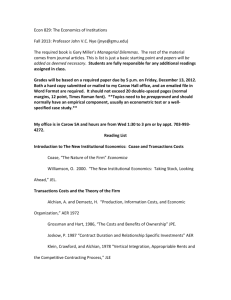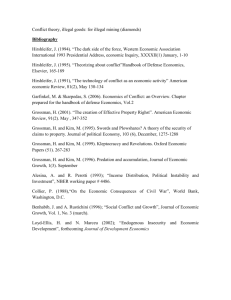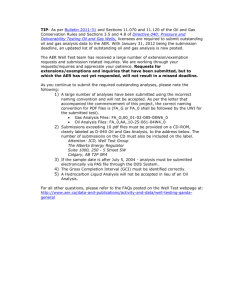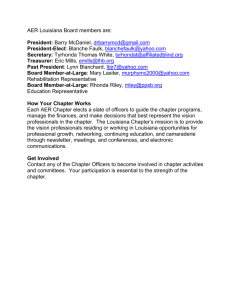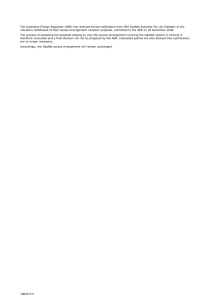Click here for syllabus
advertisement
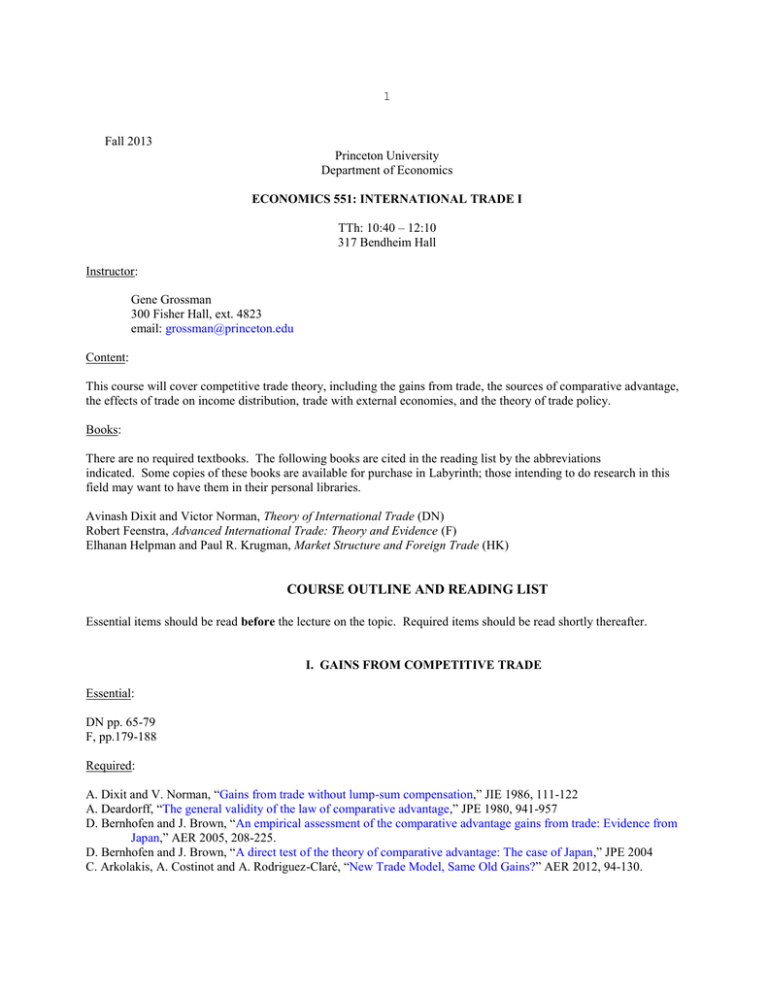
1 Fall 2013 Princeton University Department of Economics ECONOMICS 551: INTERNATIONAL TRADE I TTh: 10:40 – 12:10 317 Bendheim Hall Instructor: Gene Grossman 300 Fisher Hall, ext. 4823 email: grossman@princeton.edu Content: This course will cover competitive trade theory, including the gains from trade, the sources of comparative advantage, the effects of trade on income distribution, trade with external economies, and the theory of trade policy. Books: There are no required textbooks. The following books are cited in the reading list by the abbreviations indicated. Some copies of these books are available for purchase in Labyrinth; those intending to do research in this field may want to have them in their personal libraries. Avinash Dixit and Victor Norman, Theory of International Trade (DN) Robert Feenstra, Advanced International Trade: Theory and Evidence (F) Elhanan Helpman and Paul R. Krugman, Market Structure and Foreign Trade (HK) COURSE OUTLINE AND READING LIST Essential items should be read before the lecture on the topic. Required items should be read shortly thereafter. I. GAINS FROM COMPETITIVE TRADE Essential: DN pp. 65-79 F, pp.179-188 Required: A. Dixit and V. Norman, “Gains from trade without lump-sum compensation,” JIE 1986, 111-122 A. Deardorff, “The general validity of the law of comparative advantage,” JPE 1980, 941-957 D. Bernhofen and J. Brown, “An empirical assessment of the comparative advantage gains from trade: Evidence from Japan,” AER 2005, 208-225. D. Bernhofen and J. Brown, “A direct test of the theory of comparative advantage: The case of Japan,” JPE 2004 C. Arkolakis, A. Costinot and A. Rodriguez-Claré, “New Trade Model, Same Old Gains?” AER 2012, 94-130. 2 II. TRADE EQUILIBRIUM: PERFECT COMPETITION A. Factor Endowments: Special Models Essential: F, pp. 31-41, 88-93 R. Jones and P. Neary, “The positive theory of international trade,” in R. Jones and P. Kenen, Handbook of International Economics, vol.1, pp 14-27. Required: R. Jones, “The structure of simple general-equilibrium models.” JPE 1965. B. Factor Endowments: General Theory Essential: F, pp. 64-75, 83-88, Required: DN, chs. 2,4. HK, ch. 1 W. Ethier, “Higher dimensional trade theory,” in R. Jones and P. Kenen, Handbook of International Economics, vol.1 E. Helpman, “The factor content of foreign trade,” EJ 1984, 84-94. C. Technological Differences Essential: K. Matsuyama, “Ricardian trade theory,” in L. Blume and S. Durlauf, eds., the New Palgrave Dictionary of Economics, 2nd Edition, Macmillan. Required: R. Dornbusch, S. Fischer and P. Samuelson, “Comparative advantage, trade, and payments in a Ricardian model with a continuum of goods,” AER 1977, 823-839. D. Trefler, “International factor price differences: Leontief was right!” JPE 1993, 961-987, secs. II and III. J. Eaton and S. Kortum, “Technology, geography, and trade,” EMA, 2002, pp. 1741-1779. D. Empirical Studies of the Trade Pattern Essential: F 41-60, 76-83, 93-97. E. Helpman, “The structure of foreign trade,” Journal of Economic Perspectives 1999, 121-144. 3 Required: H. Bowen, E. Leamer and L. Sveikauskas, “Multicountry, multifactor tests of the factor abundance theory,” AER 1977, p.791-809 D. Trefler, “International Factor Price Differences: Leontief was Right!” JPE 1993, 961-987. D. Trefler, “The case of the missing trade and other HOV mysteries,” AER 1995, 1029-1046 D. Davis and D. Weinstein, “An account of global factor trade,” AER 2001, 1423-1453. A Costinot, D. Donaldson and Ivana Komunger, “What goods do countries trade: A quantitative exploration of Ricardo’s ideas,” 2010. E. Sorting: Heterogeneous Workers Essential: G. Grossman, “Heterogeneous workers and international trade,” Rev World Econ 2013. A Costinot, “An elementary theory of comparative advantage,” Ema 2009. Required: F. Ohnsorge and D. Trefer, “Sorting it out: International trade with heterogeneous works,” JPE 2007 G. Grossman and G. Maggi, “Diversity and trade,” AER 2000. A. Costinot and J. Vogel, “Matching and inequality in the world economy,” JPE 2010, pp. 747-786.. P. Antràs, L. Garicano, and E. Rossi-Hansberg, “Offshoring in a Knowledge Economy,” QJE 2006, pp. 31-77. G. Grossman, E. Helpman and P. Kircher, “Matching and Sorting in the Global Economy,” 2013. III EXTERNAL ECONOMIES AND TRADE Essential: HK, chapter 3. E. Helpman, “Increasing returns, imperfect markets and trade theory,” in in R. Jones and P. Kenen, Handbook of International Economics, vol.1. Required: W. Ethier, “Internationally decreasing costs and world trade,” JIE 1979, 1-24. G. Grossman and E. Rossi-Hansberg, “External economies and international trade redux,” QJE 2010, pp. 829-858. IV. THEORY OF TRADE POLICY A. First and Second Best Trade Policy Essential: A. Dixit, "Tax policy in open economies," in Auerbach and Feldstein (eds.), Handbook of Public Economics, 1985 4 Required: DN, chapter 5 (pp.149-163), 6 (pp.165-175) J. Bhagwati, “The generalized theory of distortions and welfare” in Bhagwati et al. eds., Trade, Balance of Payments and Growth, North Holland, 1971. C. Broda, N. Limao, and D. Weinstein, “Optimal tariffs: The evidence,” AER, 2009. C. Magee and S. Magee, “The United States is a small country in world trade,” Review of Intl. Economics, 2008, 9901004. B. The Political Economy of Trade Policy Essential: F, ch. 9 Required: G. Grossman and E. Helpman, “Protection for sale,” AER 1994, 833-850 A. Dixit and J. Londregan, “The determinants of the success of special interests in redistributive politics,” Jnl of Politics, 1996, 1132-1155. P. Goldberg and G. Maggi, “Protection for sale: An empirical investigation,” AER 1999, 1135-1155 R.E. Baldwin and C. Magee, “Is trade policy for sale: Congressional votes on recent trade bills,” Public Choice 2000, pp.79-101 C. Trade Agreements Essential: K. Bagwell and R. Staiger, “The World Trade Organization: Theory and practice,” Annu. Rev. of Econ, 2010, 223-256. C. Freund and E. Ornelas, “Regional trade agreements,” Annu. Rev. Econ, 2010, 39-66. Required: G. Grossman and E. Helpman, “Trade wars and trade talks,” JPE 1995, 675-708 K. Bagwell, “Self-enforcing trade agreements and private information” NBER 14812, 2009. G. Maggi and A. Rodríguez-Clare, “The value of trade agreements in the presence of political pressures,” JPE 1998, 574-601 A. Panagariya, “Preferential trade liberalization: The traditional theory and new developments,” JEL 2000, 287-331
